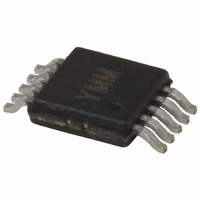MIC2174-1YMM Micrel Inc, MIC2174-1YMM Datasheet - Page 15

MIC2174-1YMM
Manufacturer Part Number
MIC2174-1YMM
Description
IC BUCK SYNC ADJ 25A 10MSOP
Manufacturer
Micrel Inc
Series
Hyper Speed Control™r
Type
Step-Down (Buck)r
Datasheet
1.MIC2174-1YMM.pdf
(27 pages)
Specifications of MIC2174-1YMM
Internal Switch(s)
No
Synchronous Rectifier
Yes
Number Of Outputs
1
Voltage - Output
0.8 ~ 5.5 V
Frequency - Switching
300kHz
Voltage - Input
3 ~ 5.5 V
Operating Temperature
-40°C ~ 125°C
Mounting Type
Surface Mount
Package / Case
10-MSOP, Micro10™, 10-uMAX, 10-uSOP
Power - Output
421mW
Primary Input Voltage
40V
No. Of Outputs
2
Output Current
25A
Voltage Regulator Case Style
MSOP
No. Of Pins
10
Operating Temperature Range
-40°C To +125°C
Svhc
No SVHC (15-Dec-2010)
Lead Free Status / RoHS Status
Lead free / RoHS Compliant
Current - Output
-
Lead Free Status / RoHS Status
Lead free / RoHS Compliant, Lead free / RoHS Compliant
Other names
576-3546-5
Available stocks
Company
Part Number
Manufacturer
Quantity
Price
Company:
Part Number:
MIC2174-1YMM
Manufacturer:
Micrel Inc
Quantity:
135
Micrel, Inc.
Making the assumption that the turn-on and turn-off
transition times are equal; the transition times can be
approximated by:
where:
C
I
The total high-side MOSFET switching loss is:
where:
t
V
f
The high-side MOSFET switching losses increase with
the input voltage V
turn-off time. The low-side MOSFET switching losses
are negligible and can be ignored for these calculations.
Inductor Selection
Values for inductance, peak, and RMS currents are
required to select the output inductor. The input and
output voltages and the inductance value determine the
peak-to-peak inductor ripple current. Generally, higher
inductance values are used with higher input voltages.
Larger peak-to-peak ripple currents will increase the
power dissipation in the inductor and MOSFETs. Larger
output ripple currents will also require more output
capacitance to smooth out the larger ripple current.
Smaller peak-to-peak ripple currents require a larger
inductance value and therefore a larger and more
expensive inductor. A good compromise between size,
loss and cost is to set the inductor ripple current to be
equal to 20% of the maximum output current. The
inductance value is calculated by Equation 13:
where:
f
20% = ratio of AC ripple current to DC output current
V
G
T
SW
SW
September 2010
D
HSD(max)
ISS
= Switching transition time
= gate-drive current
= Body diode drop (0.5V)
= Switching Frequency (300kHz)
= switching frequency, 300 kHz
P
L
and C
AC
=
t
V
= maximum power stage input voltage
T
=
HSD(max)
OSS
(V
V
=
OUT
HSD
C
are measured at V
ISS
×
+
×
×
(V
HSD
V
f
V
D
sw
HSD(max)
IN
)
due to the longer turn-on time and
×
×
+
20%
I
I
PK
G
C
OSS
×
−
×
t
V
T
I
×
OUT(max)
OUT
×
DS
V
f
HSD
SW
= 0
)
(11)
(13)
(12)
15
The peak-to-peak inductor current ripple is:
The peak inductor current is equal to the average output
current plus one half of the peak-to-peak inductor current
ripple.
The RMS inductor current is used to calculate the I
losses in the inductor.
Maximizing efficiency requires both the proper selection
of core material and the minimizing of winding
resistance. The high frequency operation of the
MIC2174/MIC2174C requires the use of ferrite materials
for all but the most cost sensitive applications.
Lower cost iron powder cores may be used but the
increase in core loss will reduce the efficiency of the
power supply. This is especially noticeable at low output
power. The winding resistance decreases efficiency at
the higher output current levels. The winding resistance
must be minimized although this usually comes at the
expense of a larger inductor. The power dissipated in the
inductor is equal to the sum of the core and copper
losses. At higher output loads, the core losses are
usually insignificant and can be ignored. At lower output
currents, the core losses can be a significant contributor.
Core loss information is usually available from the
magnetics vendor. Copper loss in the inductor is
calculated by Equation 17:
The resistance of the copper wire, R
with the temperature. The value of the winding
resistance used should be at the operating temperature.
P
WINDING(Ht)
I
P
I
Δ
L(pk)
L(RMS)
INDUCTOR(Cu)
I
= R
L(pp)
=I
WINDING(20°C)
=
OUT(max)
=
V
OUT
I
OUT(max)
V
= I
HSD(max)
×
+ 0.5
(V
L(RMS)
HSD(max)
× (1 + 0.0042 × (T
2
×
2
+
×
× R
ΔI
f
MIC2174/MIC2174C
ΔI
sw
L(pp)
−
L(PP)
12
WINDING
×
V
WINDING
L
OUT
M9999-091310-C
2
)
, increases
H
– T
20°C
(14)
(15)
(16)
(17)
(18)
2
R
))












